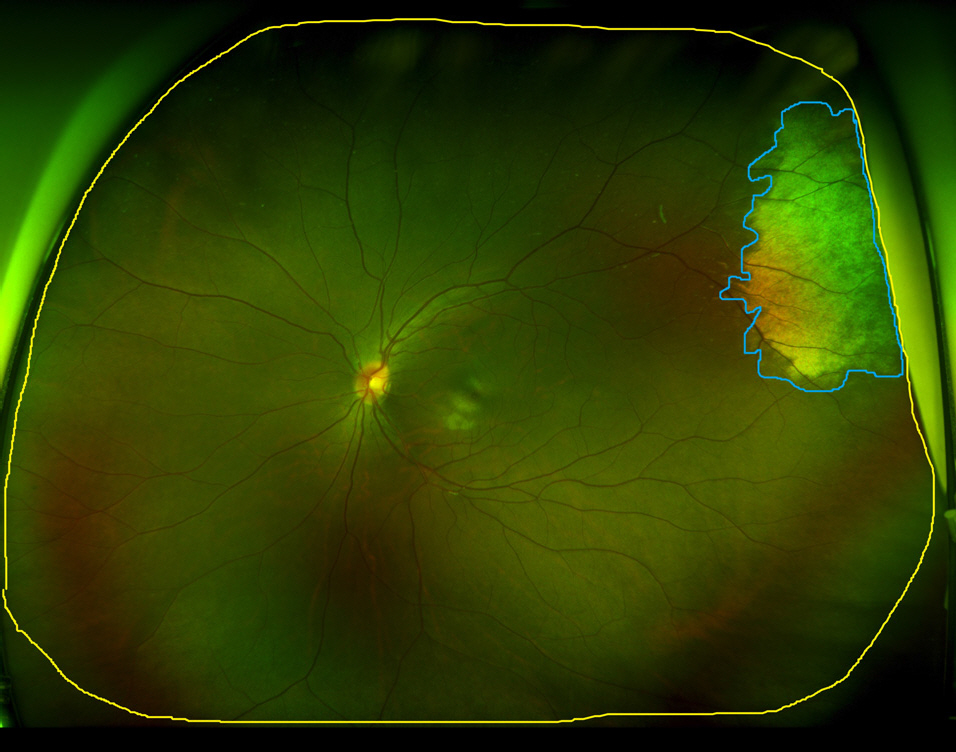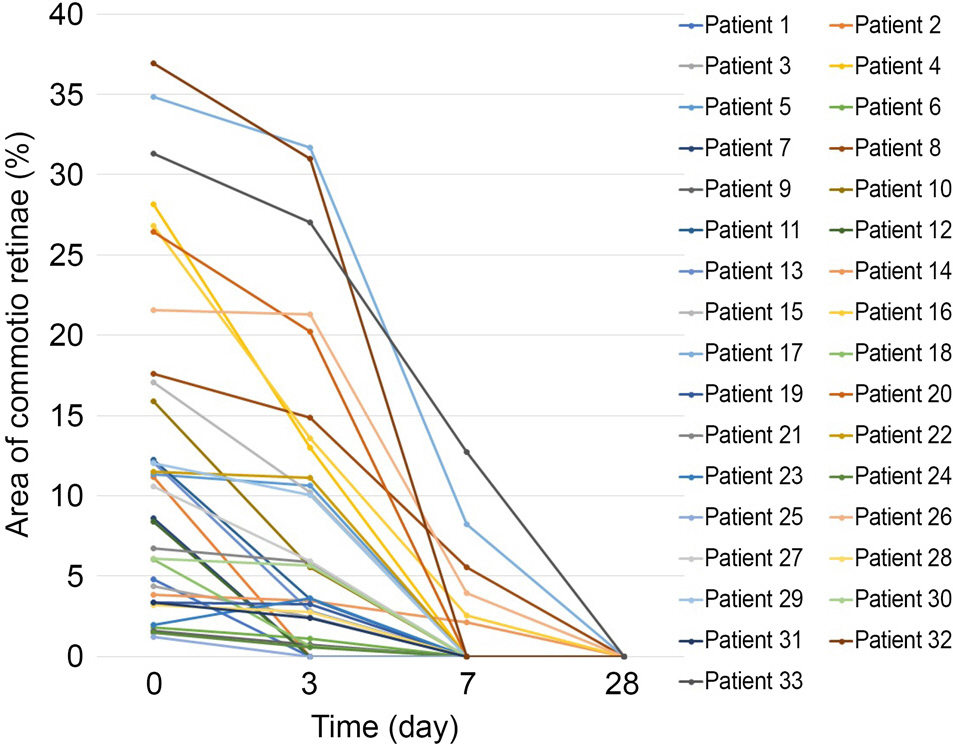J Korean Ophthalmol Soc.
2020 Mar;61(3):243-249. 10.3341/jkos.2020.61.3.243.
Serial Follow-up of Commotio Retinae Using Ultra-wide Field Imaging
- Affiliations
-
- 1Department of Ophthalmology, Bucheon St. Mary's Hospital, College of Medicine, The Catholic University of Korea, Bucheon, Korea. md.jiwon@gmail.com
- KMID: 2471764
- DOI: http://doi.org/10.3341/jkos.2020.61.3.243
Abstract
- PURPOSE
To quantify the size of commotio retinae and investigate its spontaneous resolution over time using ultra-wide field (UWF) color fundus photography.
METHODS
We analyzed serial UWF color fundus photographs of 33 eyes of 33 ocular trauma patients with commotio retinae. Total visible retinal areas and the areas of commotio retinae were measured at baseline, 3 days, 1 week, and 4 weeks from the initial traumatic event.
RESULTS
The median time of observation was 10.8 ± 12.1 (4-44) weeks. Spontaneous resolution of commotio retinae was observed in all patients, and no patients experienced any complications during the follow-up period. The mean percentage of commotio retinae at 3 days significantly decreased compared to the baseline (8.51 ± 9.66% versus 12.23 ± 10.39%; p < 0.001), and more decreased at 1 week (1.04 ± 2.75%; p < 0.001), but no significant differences were observed between 1 week and 4 weeks (0.00 ± 0.00%; p = 0.219). The spontaneous resolution percentages during the first 3 days, between 3 days and 1 week, and during the next 4 weeks were 12.97 ± 13.44%/day, 19.62 ± 9.22%/day, and 0.87 ± 1.87%/day, respectively (p = 0.192 and p < 0.001, respectively). The resolution rate was higher during the first 1 week.
CONCLUSIONS
We quantified the size of commotio retinae using UWF color fundus photography. Most patients with commotio retinae resolved spontaneously during the first 1 week following trauma, and all cases completely resolved at 1 month without any complications.
Figure
Reference
-
References
1. Berlin R. On the so-called Commotio retinae. Klin Mbl Augenheilk. 1873; 11:42–78.2. Sipperley JO, Quigley HA, Gass DM. Traumatic retinopathy in primates. The explanation of commotio retinae. Arch Ophthalmol. 1978; 96:2267–73.3. Mansour AM, Green WR, Hogge C. Histopathology of commotio retinae. Retina. 1992; 12:24–8.
Article4. Sony P, Venkatesh P, Gadaginamath S, Garg SP. Optical coherence tomography findings in commotio retina. Clin Exp Ophthalmol. 2006; 34:621–3.
Article5. Hart J, Frank H. Retinal opacification after blunt non-perforating concussional injuries to the globe. A clinical and retinal fluorescein angiographic study. Trans Ophthalmol Soc U K. 1975; 95:94–100.6. Oh J, Jung JH, Moon SW, et al. Commotio retinae with spectral-abdominal optical coherence tomography. Retina. 2011; 31:2044–9.7. Ghasemi Falavarjani K, Wang K, Khadamy J, Sadda SR. Ultra-wide-field imaging in diabetic retinopathy; an overview. J Curr Ophthalmol. 2016; 28:57–60.
Article8. Witmer MT, Parlitsis G, Patel S, Kiss S. Comparison of abdominal-field fluorescein angiography with the Heidelberg Spectralis((R)) noncontact abdominalfield module versus the Optos((R)) Optomap((R)). Clin Ophthalmol. 2013; 7:389–94.9. Hirano T, Imai A, Kasamatsu H, et al. Assessment of diabetic retinopathy using two abdominal-field fundus imaging systems, the Clarus(R) and Optos™ systems. BMC Ophthalmol. 2018; 18:332.
Article10. Tang M, Hui YN, Li YY, et al. Evaluation of traumatic retinopathy with abdominal field imaging under corneal scar or fixed small pupil. Int J Ophthalmol. 2018; 11:1371–6.11. Kim DR, Hong EH, Shin YU, et al. Utility of abdominal fundus photography in patients with acute blunt ocular trauma. J Korean Ophthalmol Soc. 2019; 60:428–33.12. Bunt-Milam AH, Black RA, Bensinger RE. Breakdown of the outer blood-retinal barrier in experimental commotio retinae. Exp Eye Res. 1986; 43:397–412.
Article13. Liem AT, Keunen JE, van Norren D. Reversible cone photo-receptor injury in commotio retinae of the macula. Retina. 1995; 15:58–61.
Article14. Itakura H, Kishi S. Restored photoreceptor outer segment in commotio retinae. Ophthalmic Surg Lasers Imaging. 2011; 42:Online:. e29–31.
Article15. Blanch RJ, Good PA, Shah P, et al. Visual outcomes after blunt abdominal trauma. Ophthalmology. 2013; 120:1588–91.
- Full Text Links
- Actions
-
Cited
- CITED
-
- Close
- Share
- Similar articles
-
- Utility of Ultra-wide Fundus Photography in Patients with Acute Blunt Ocular Trauma
- A Case of the Commotio Retinae with the Myopia, Hypotony and Mydiriasis
- Evaluation of the Central Macula in Commotio Retinae Not Associated with Other Types of Traumatic Retinopathy
- Diagnostic Availability of Ultra-Wide-field Fundus Imaging in Korean Patient with Retinal Break
- The Extent of Silicone Oil Emulsification Revealed by Ultra-wide-field Fundus Photography and Optical Coherence Tomography






